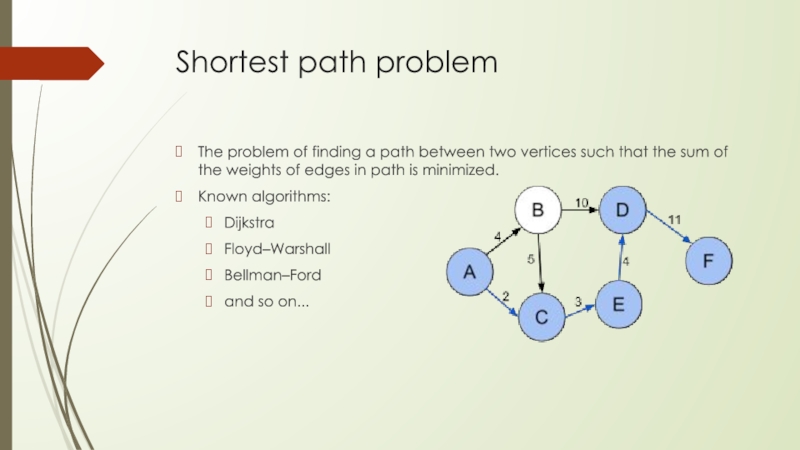- Главная
- Разное
- Дизайн
- Бизнес и предпринимательство
- Аналитика
- Образование
- Развлечения
- Красота и здоровье
- Финансы
- Государство
- Путешествия
- Спорт
- Недвижимость
- Армия
- Графика
- Культурология
- Еда и кулинария
- Лингвистика
- Английский язык
- Астрономия
- Алгебра
- Биология
- География
- Детские презентации
- Информатика
- История
- Литература
- Маркетинг
- Математика
- Медицина
- Менеджмент
- Музыка
- МХК
- Немецкий язык
- ОБЖ
- Обществознание
- Окружающий мир
- Педагогика
- Русский язык
- Технология
- Физика
- Философия
- Химия
- Шаблоны, картинки для презентаций
- Экология
- Экономика
- Юриспруденция
Shortest paths and spanning trees in graphs презентация
Содержание
- 2. Shortest paths and spanning trees in graphs Lyzhin Ivan, 2015
- 3. Shortest path problem The problem of finding
- 4. Dijkstra algorithm There are two sets of
- 5. Trivial implementation void dijkstra(int s) { vector
- 6. Implementation with set void dijkstra(int s) {
- 7. Implementation with priority queue void dijkstra(int s)
- 8. Floyd–Warshall algorithm Initially, dist[u][u]=0 and for each
- 9. Implementation void floyd_warshall() { vector dist(n, vector(n,
- 10. Bellman–Ford algorithm |V|-1 iterations, on each we
- 11. Implementation void bellman_ford(int s) { vector dist(n,
- 12. Minimal spanning tree A spanning tree T
- 13. Prim’s algorithm Initialize a tree with a
- 14. Implementation void prima() { set q; //(dist[u],
- 15. Kruskal’s algorithm Create a forest F (a
- 16. Trivial implementation void trivial_kruskal() { vector color(n);
- 17. Implementation with DSU void kruskal() { DSU
- 18. Disjoint-set-union (DSU) Two main operations: Find(U) –
- 19. Implementation struct DSU { vector p;
- 20. Path compression When we go up, we
- 21. Union by size int unionSets(int u, int
- 22. Links https://en.wikipedia.org/wiki/Dijkstra%27s_algorithm https://en.wikipedia.org/wiki/Floyd–Warshall_algorithm https://en.wikipedia.org/wiki/Bellman–Ford_algorithm https://en.wikipedia.org/wiki/Kruskal%27s_algorithm https://en.wikipedia.org/wiki/Prim%27s_algorithm https://en.wikipedia.org/wiki/Disjoint-set_data_structure http://e-maxx.ru/algo/topological_sort
- 23. Home task http://ipc.susu.ac.ru/210-2.html?problem=1903 http://ipc.susu.ac.ru/210-2.html?problem=186 http://acm.timus.ru/problem.aspx?space=1&num=1982 http://acm.timus.ru/problem.aspx?space=1&num=1119 http://acm.timus.ru/problem.aspx?space=1&num=1210 http://acm.timus.ru/problem.aspx?space=1&num=1272
Слайд 3Shortest path problem
The problem of finding a path between two vertices
such that the sum of the weights of edges in path is minimized.
Known algorithms:
Dijkstra
Floyd–Warshall
Bellman–Ford
and so on...
Known algorithms:
Dijkstra
Floyd–Warshall
Bellman–Ford
and so on...
Слайд 4Dijkstra algorithm
There are two sets of vertices – visited and unvisited.
For
visited vertices we know minimal distance from start. For unvisited vertices we know some distance which can be not minimal.
Initially, all vertices are unvisited and distance to each vertex is INF. Only distance to start node is equal 0.
On each step choose unvisited vertex with minimal distance. Now it’s visited vertex. And try to relax distance of neighbors.
Complexity: trivial implementation O(|V|^2+|E|)
implementation with set O(|E|log|V|+|V|log|V|)
Initially, all vertices are unvisited and distance to each vertex is INF. Only distance to start node is equal 0.
On each step choose unvisited vertex with minimal distance. Now it’s visited vertex. And try to relax distance of neighbors.
Complexity: trivial implementation O(|V|^2+|E|)
implementation with set O(|E|log|V|+|V|log|V|)
Слайд 5Trivial implementation
void dijkstra(int s)
{
vector mark(n, false);
vector d(n, INF);
d[s] = 0;
for (int
i = 0; i < n; ++i)
{
int u = -1;
for (int j = 0; j < n; ++j)
if (!mark[j] && (u == -1 || d[j] < d[u]))
u = j;
mark[u] = true;
for (v - сосед u)
d[v] = min(d[v], d[u] + weight(uv));
}
}
{
int u = -1;
for (int j = 0; j < n; ++j)
if (!mark[j] && (u == -1 || d[j] < d[u]))
u = j;
mark[u] = true;
for (v - сосед u)
d[v] = min(d[v], d[u] + weight(uv));
}
}
Слайд 6Implementation with set
void dijkstra(int s)
{
set q; //(dist[u], u)
vector dist(n,
INF);
dist[s] = 0;
q.insert(mp(0, s));
while(!q.empty())
{
int cur = q.begin()->second;
q.erase(q.begin());
for(auto e : g[cur])
if(dist[e.first] > dist[cur]+e.second)
{
q.erase(mp(dist[e.first], e.first));
dist[e.first] = dist[cur] + e.second;
q.insert(mp(dist[e.first], e.first));
}
}
}
dist[s] = 0;
q.insert(mp(0, s));
while(!q.empty())
{
int cur = q.begin()->second;
q.erase(q.begin());
for(auto e : g[cur])
if(dist[e.first] > dist[cur]+e.second)
{
q.erase(mp(dist[e.first], e.first));
dist[e.first] = dist[cur] + e.second;
q.insert(mp(dist[e.first], e.first));
}
}
}
Слайд 7Implementation with priority queue
void dijkstra(int s)
{
priority_queue q; //(dist[u], u)
vector
dist(n, INF);
dist[s] = 0;
q.push(mp(0, s));
while(!q.empty())
{
int cur = q.top().second;
int cur_d = -q.top().first; q.pop();
if(cur_d > dist[cur]) continue;
for(auto e : g[cur])
if(dist[e.first] > dist[cur]+e.second)
{
dist[e.first] = dist[cur] + e.second;
q.push(mp(-dist[e.first], e.first));
}
}
}
dist[s] = 0;
q.push(mp(0, s));
while(!q.empty())
{
int cur = q.top().second;
int cur_d = -q.top().first; q.pop();
if(cur_d > dist[cur]) continue;
for(auto e : g[cur])
if(dist[e.first] > dist[cur]+e.second)
{
dist[e.first] = dist[cur] + e.second;
q.push(mp(-dist[e.first], e.first));
}
}
}
Слайд 8Floyd–Warshall algorithm
Initially, dist[u][u]=0 and for each edge (u, v): dist[u][v]=weight(u, v)
On
iteration k we let use vertex k as intermediate vertex and for each pair of vertices we try to relax distance.
dist[u][v] = min(dist[u][v], dist[u][k]+dist[k][v])
Complexity: O(|V|^3)
dist[u][v] = min(dist[u][v], dist[u][k]+dist[k][v])
Complexity: O(|V|^3)
Слайд 9Implementation
void floyd_warshall()
{
vector dist(n, vector(n, INF));
for (int i = 0; i
< n; ++i)
dist[i][i] = 0;
for (int i = 0; i < n; ++i)
for (auto e : g[i])
dist[i][e.first] = e.second;
for (int k = 0; k < n; ++k)
for (int i = 0; i < n; ++i)
for (int j = 0; j < n; ++j)
dist[i][j] = min(dist[i][j], dist[i][k] + dist[k][j]);
}
dist[i][i] = 0;
for (int i = 0; i < n; ++i)
for (auto e : g[i])
dist[i][e.first] = e.second;
for (int k = 0; k < n; ++k)
for (int i = 0; i < n; ++i)
for (int j = 0; j < n; ++j)
dist[i][j] = min(dist[i][j], dist[i][k] + dist[k][j]);
}
Слайд 10Bellman–Ford algorithm
|V|-1 iterations, on each we try relax distance with all
edges.
If we can relax distance on |V| iteration then negative cycle exists in graph
Why |V|-1 iterations? Because the longest way without cycles from one node to another one contains no more |V|-1 edges.
Complexity O(|V||E|)
If we can relax distance on |V| iteration then negative cycle exists in graph
Why |V|-1 iterations? Because the longest way without cycles from one node to another one contains no more |V|-1 edges.
Complexity O(|V||E|)
Слайд 11Implementation
void bellman_ford(int s)
{
vector dist(n, INF);
dist[s] = 0;
for (int i = 0;
i < n - 1; ++i)
for (auto e : edges)
dist[e.v] = min(dist[e.v], dist[e.u] + e.weight);
for (auto e : edges)
if (dist[e.v] > dist[e.u] + e.weight)
cout << "Negative cycle!" << endl;
}
for (auto e : edges)
dist[e.v] = min(dist[e.v], dist[e.u] + e.weight);
for (auto e : edges)
if (dist[e.v] > dist[e.u] + e.weight)
cout << "Negative cycle!" << endl;
}
Слайд 12Minimal spanning tree
A spanning tree T of an undirected graph G
is a subgraph that includes all of the vertices of G that is a tree.
A minimal spanning tree is a spanning tree and sum of weights is minimized.
A minimal spanning tree is a spanning tree and sum of weights is minimized.
Слайд 13Prim’s algorithm
Initialize a tree with a single vertex, chosen arbitrarily from
the graph.
Grow the tree by one edge: of the edges that connect the tree to vertices not yet in the tree, find the minimum-weight edge, transfer it to the tree and try to relax distance for neighbors.
Repeat step 2 (until all vertices are in the tree).
Complexity: trivial implementation O(|V|^2+|E|)
implementation with set O(|E|log|V|+|E|)
Grow the tree by one edge: of the edges that connect the tree to vertices not yet in the tree, find the minimum-weight edge, transfer it to the tree and try to relax distance for neighbors.
Repeat step 2 (until all vertices are in the tree).
Complexity: trivial implementation O(|V|^2+|E|)
implementation with set O(|E|log|V|+|E|)
Слайд 14Implementation
void prima()
{
set q; //(dist[u], u)
vector dist(n, INF);
dist[0] = 0;
q.insert(mp(0,
0));
while (!q.empty())
{
int cur = q.begin()->second;
q.erase(q.begin());
for (auto e : g[cur])
if (dist[e.first] > e.second)
{
q.erase(mp(dist[e.first], e.first));
dist[e.first] = e.second;
q.insert(mp(dist[e.first], e.first));
}
}
}
while (!q.empty())
{
int cur = q.begin()->second;
q.erase(q.begin());
for (auto e : g[cur])
if (dist[e.first] > e.second)
{
q.erase(mp(dist[e.first], e.first));
dist[e.first] = e.second;
q.insert(mp(dist[e.first], e.first));
}
}
}
Слайд 15Kruskal’s algorithm
Create a forest F (a set of trees), where each
vertex in the graph is a separate tree
Create a set S containing all the edges in the graph
While S is nonempty and F is not yet spanning:
remove an edge with minimum weight from S
if the removed edge connects two different trees then add it to the forest F, combining two trees into a single tree
Complexity: trivial O(|V|^2+|E|log|E|)
with DSU O(|E|log|E|)
Create a set S containing all the edges in the graph
While S is nonempty and F is not yet spanning:
remove an edge with minimum weight from S
if the removed edge connects two different trees then add it to the forest F, combining two trees into a single tree
Complexity: trivial O(|V|^2+|E|log|E|)
with DSU O(|E|log|E|)
Слайд 16Trivial implementation
void trivial_kruskal()
{
vector color(n);
for (int i = 0; i < n;
++i)
color[i] = i;
sort(edges.begin(), edges.end());
for(auto e : edges)
if(color[e.u]!=color[e.v])
{
add_to_spanning_tree(e);
int c1 = color[e.u];
int c2 = color[e.v];
for (int i = 0; i < n; ++i)
if (color[i] == c1)
color[i] = c2;
}
}
color[i] = i;
sort(edges.begin(), edges.end());
for(auto e : edges)
if(color[e.u]!=color[e.v])
{
add_to_spanning_tree(e);
int c1 = color[e.u];
int c2 = color[e.v];
for (int i = 0; i < n; ++i)
if (color[i] == c1)
color[i] = c2;
}
}
Слайд 17Implementation with DSU
void kruskal()
{
DSU dsu(n);
sort(edges.begin(), edges.end());
for(auto e : edges)
if(dsu.findSet(e.u)!=dsu.findSet(e.v))
{
add_to_spanning_tree(e);
dsu.unionSets(e.u, e.v);
}
}
Слайд 18Disjoint-set-union (DSU)
Two main operations:
Find(U) – return root of set, which contains
U, complexity O(1)
Union(U, V) – join sets, which contain U and V, complexity O(1)
After creating DSU:
After some operations:
Union(U, V) – join sets, which contain U and V, complexity O(1)
After creating DSU:
After some operations:
Слайд 19Implementation
struct DSU
{
vector p;
DSU(int n) {
p.resize(n);
for (int i = 0; i
n; ++i)
p[i] = i;
}
int find(int u) {
return u == p[u] ? u : find(p[u]);
}
void merge(int u, int v) {
int pu = find(u);
int pv = find(v);
p[pv] = pu;
}
};
p[i] = i;
}
int find(int u) {
return u == p[u] ? u : find(p[u]);
}
void merge(int u, int v) {
int pu = find(u);
int pv = find(v);
p[pv] = pu;
}
};
Слайд 20Path compression
When we go up, we can remember root of set
for each vertex in path
int findSet(int u)
{
return u == p[u] ? u : p[u] = findSet(p[u]);
}
Слайд 21Union by size
int unionSets(int u, int v)
{
int pu = findSet(u);
int pv
= findSet(v);
if (pu == pv) return;
if (sizes[pu] < sizes[pv])
swap(pu, pv);
p[pv] = pu;
sizes[pu] += sizes[pv];
}
if (pu == pv) return;
if (sizes[pu] < sizes[pv])
swap(pu, pv);
p[pv] = pu;
sizes[pu] += sizes[pv];
}
DSU(int size)
{
p.resize(size);
sizes.resize(size, 1);
for (int i = 0; i < size; ++i)
p[i] = i;
}




![Trivial implementationvoid dijkstra(int s){vector mark(n, false);vector d(n, INF);d[s] = 0;for (int i = 0; i](/img/tmb/5/476559/388e6f717ce9a1cdde1aad49d261f43f-800x.jpg)
![Implementation with setvoid dijkstra(int s){set q; //(dist[u], u)vector dist(n, INF);dist[s] = 0;q.insert(mp(0, s));while(!q.empty()){int cur =](/img/tmb/5/476559/82fdde79cc4576f503d7fa803db1fea7-800x.jpg)
![Implementation with priority queuevoid dijkstra(int s){priority_queue q; //(dist[u], u)vector dist(n, INF);dist[s] = 0;q.push(mp(0, s));while(!q.empty()){int cur](/img/tmb/5/476559/11859829a1215d22bb6e6f91e2d3b9a9-800x.jpg)
![Floyd–Warshall algorithmInitially, dist[u][u]=0 and for each edge (u, v): dist[u][v]=weight(u, v)On iteration k we let](/img/tmb/5/476559/1931136a24b86efefb5f9f215f17e12e-800x.jpg)
![Implementationvoid floyd_warshall(){vector dist(n, vector(n, INF));for (int i = 0; i < n; ++i) dist[i][i] = 0;for](/img/tmb/5/476559/4402bec2969f57505605e20cd6880d30-800x.jpg)

![Implementationvoid bellman_ford(int s){vector dist(n, INF);dist[s] = 0;for (int i = 0; i < n -](/img/tmb/5/476559/ced4b87ea91d9d83d06496caf2dcda55-800x.jpg)


![Implementationvoid prima(){set q; //(dist[u], u)vector dist(n, INF);dist[0] = 0;q.insert(mp(0, 0));while (!q.empty()){int cur = q.begin()->second;q.erase(q.begin());for (auto](/img/tmb/5/476559/3fe942aaf6269dbb323d8a2dad50aed2-800x.jpg)

![Trivial implementationvoid trivial_kruskal(){vector color(n);for (int i = 0; i < n; ++i) color[i] = i;sort(edges.begin(), edges.end());for(auto](/img/tmb/5/476559/7299a040c387f67e5059b49a29ffa302-800x.jpg)


![Implementationstruct DSU{vector p;DSU(int n) {p.resize(n);for (int i = 0; i < n; ++i) p[i] = i;}int](/img/tmb/5/476559/286323b4ffae5c427553a9bb9393100e-800x.jpg)









